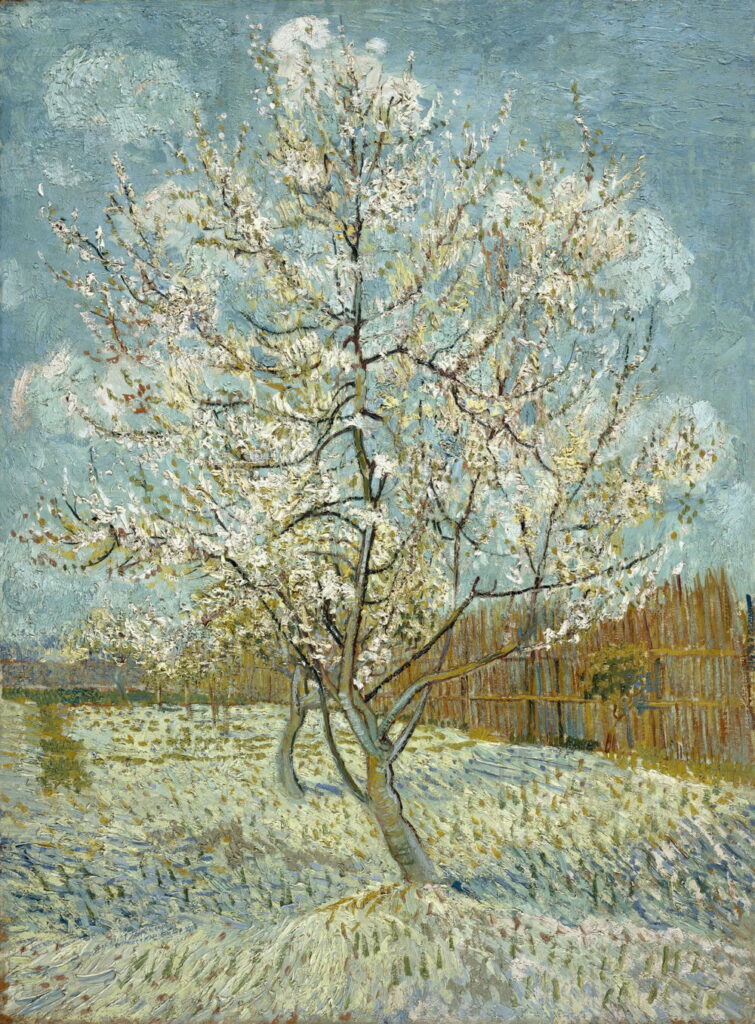Blossom festival 2024: 19th century

If you’ve ever lived hundreds of miles from the nearest tree, you’ll know how desolate life is without their company. Over two periods each year we should all get out and celebrate with our trees, during the blossom festival each spring, and in leaf-peeping in the autumn/fall. If you’re in a northern temperate latitude, now’s the time that you should be watching for the full flush of cherry and other flowering trees. In Washington DC its blossom festival extends a month from mid-March, in Japan rather later, and it’s even celebrated in Perth, in Western Australia, during the austral Spring.
This weekend I celebrate the end of the winter with two days of paintings of blossom on trees, today’s from the nineteenth century, and tomorrow from the twentieth.
Samuel Palmer (1805–1881), In a Shoreham Garden (c 1830), watercolour on paper, dimensions not known, Victoria and Albert Museum, London. Image courtesy of and © Victoria and Albert Museum, London.
Early in Samuel Palmer’s career, when he was living in Shoreham in Kent, he painted this watercolour of exuberant blossom In a Shoreham Garden, in about 1830.
John Everett Millais (1829–1896), Spring (Apple Blossoms) (1856-59), oil on canvas, 110.4 x 172.7 cm, Lady Lever Art Gallery, Liverpool, England. Wikimedia Commons.
The Pre-Raphaelite movement emphasised painting from life; when John Everett Millais came to paint Flora and her Spring, in 1856-59, he added subtle allusions to Botticelli’s famous Primavera and classical myth. The blossom here is on apple trees, which are probably second only to May or Hawthorn in the English countryside at this time of year. At the far right, beside this group of elegant young women, is the scythe of Father Time. Two of the group have baskets full of Spring flowers, and three have flowers in their hair.
Charles-François Daubigny (1817–1878), Spring Landscape (1862), oil on canvas, 133 x 240 cm, Alte Nationalgalerie, Berlin. Wikimedia Commons.
In the year that Charles-François Daubigny moved to Auvers-sur-Oise and founded the artists’ colony there, he painted this blossom-rich view of the Spring Landscape (1862). Vincent van Gogh was later to spend his final two months of painting near here.
Jean-François Millet (1814–1875), Spring (1868-1873), oil on canvas, 86 x 111 cm, Musée d’Orsay, Paris. Wikimedia Commons.
In the closing years of Jean-François Millet’s life, he painted a commissioned series including this startling study of light, Spring (1868-73). This features a double rainbow at the upper left, with fleeting sunshine flooding the centre and dazzling on the abundant blossom. From the crops and seasonal flowers in the foreground to the inky black shower-clouds in the sky, this is a perfect summary of Spring in the countryside.
Alfred Sisley (1839–1899), The Terrace at Saint-Germain, Spring (1875), oil on canvas, 73.6 x 99.6 cm, Walters Art Museum, Baltimore, MD. Wikimedia Commons.
My favourite Impressionist painting of blossom has to be Alfred Sisley’s panorama of The Terrace at Saint-Germain, Spring, painted soon after he had moved to Marly-le-Roi in 1875.
Alice Havers (1850–1890), Washerwomen (date not known), oil, dimensions not known, Walker Art Gallery, Liverpool, England. Wikimedia Commons.
Alice Havers’ Washerwomen, which given her tragically brief life must have been painted around 1880, shows a large orchard of fruit trees in blossom on the far side of the river.
By any measure, the nineteenth century master of blossom was Vincent van Gogh. Like several of his contemporaries, he had become a collector of Japanese woodcut prints, and became fascinated by one of their dominant themes, cherry blossom.
Vincent van Gogh (1853–1890), The Pink Orchard (1888), oil on canvas, 64 x 80 cm, Van Gogh Museum, Amsterdam. Wikimedia Commons.
Before he went to Arles, Vincent van Gogh had copied Utagawa Hiroshige’s woodblock print The Plum Orchard in Kameido. Shortly after his arrival there in 1888, the fruit trees came into flower, and he painted a triptych for his brother Theo’s apartment, including The Pink Orchard above, and The Pink Peach Tree below.
Vincent van Gogh (1853–1890), The Pink Peach Tree (1888), oil on canvas, 80.5 x 59 cm, Van Gogh Museum, Amsterdam. Wikimedia Commons.
Van Gogh’s approach to painting blossoming fruit trees is completely different from that of the Japanese prints. His trees are built anatomically, with trunk and branches drawn in outline, often using contrasting colour. Flowers are applied using impasto; sadly some of these have faded since, and some paint that now appears white or off-white was originally pinker.
Vincent van Gogh (1853–1890), View of Arles, Flowering Orchards (1889), oil on canvas, 72 × 92 cm, Neue Pinakothek, Munich. Wikimedia Commons.
View of Arles, Flowering Orchards (1889) is a complex composition, with trunks in the foreground, fruit trees in flower in the middle distance, and the town of Arles behind, integrating his previous explorations of each element.
Carl Larsson (1853–1919), Apple Blossom (1894), watercolour, dimensions not known, Private collection. Wikimedia Commons.
Among Carl Larsson’s many intimate views of life at home is this watercolour of his daughter under the Apple Blossom from 1894. He uses his favourite colour contrast between the earth red of the barns behind with the pink of the girl’s bonnet, against the rich green vegetation around her.
Paul Sérusier (1864–1927), The White Cow (c 1895), tempera on canvas, 60 x 73 cm, Muzeum Narodowe w Warszawie, Warsaw, Poland. Wikimedia Commons.
Some sixty-five years after Palmer’s exuberant clouds of blossom, Paul Sérusier used a similar technique in The White Cow, from about 1895.
Laurits Andersen Ring (1854–1933), Spring. Ebba and Sigrid Kähler (1895), oil on canvas, 189.5 x 159 cm, Den Hirschsprungske Samling, Copenhagen, Denmark. Wikimedia Commons.
Laurits Andersen Ring’s finely detailed double portrait of Spring. Ebba and Sigrid Kähler from 1895 appears to show a mother and her daughter talking in their garden, but the two are in fact sisters. At the right is Sigrid, the year before her wedding, at the left is her sister Ebba, who was fifteen at the time. Ring uses a light touch with the blossom and spring flowers to avoid them overwhelming the figures.
Helen Allingham (1848-1926), A Buckinghamshire house at Penstreet (c 1900), watercolour, 36 x 50.5 cm, Private collection. Wikimedia Commons.
Helen Allingham’s Buckinghamshire house at Penstreet (c 1900) shows a house in the hamlet of Penn Street, near the village of Penn, in Buckinghamshire, England. This remains a relatively unspoilt part of the Chilterns to the north-west of London.



